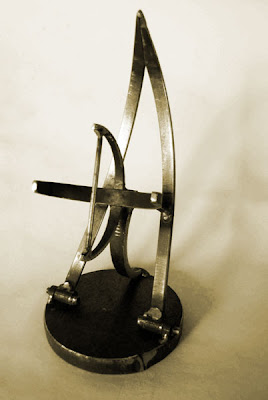
Phil Plante wrote this in the November 2008
The Meterorite, newsletter of the MVAS (
Mahoning Valley Astronomical Society):
"During the 1980’s there continued to be an influx of YSU students and planetarium staff into the MVAS. This had all started a decade earlier with Ron Parise, Warren Young and Ed Bishop becoming MVAS members. Keeping with this trend, in March of 1985, Rick had come aboard as a member of the MVAS. By the time summer came around Rick was involved in the first of his many observatory projects. He helped rebuild the roof around the 16” dome when it was removed on July 27th. This was done in order raise the circular tracks by 6 inches to solve a leaky roof problem. For most members this would have been enough volunteer work. But Rick offered more. Along with his workload as a planetarium technician and producer, he took on double duty as the MVAS Treasurer and as the Observatory Director until 1988. Rick also ran the annual Christmas raffle in 1986 and 1987. During the winter of ’86-’87 he also supervised the re-tooling of the 8” focuser and drive; the machine work being done at a YSU machine shop.
During the 1990’s Rick served as master of ceremonies and even as keynote speaker for many of the MVAS-OTAA meetings. He blossomed in the field of photography, especially capturing conjunctions, planetary alignments, solstice photography and eclipses. He had traveled to the snowy landscape of Canada and to the sunny beaches of Baja, Mexico for total solar eclipses. In 1994, he flew into Toledo, OH to be on the centerline for the May 10 annular eclipse. He captured a timed multiple exposure sequence of this eclipse on one frame. He was proud of it and rightly so. It is often displayed in the planetarium. After this eclipse flight, Rick seemed to become increasingly interested in space flight and aviation in general. In April of 1996, he traveled to Russia for a tour of the old Soviet space facilities at Star City. Not long afterwards he received a pilot’s license for gliding. He soon joined the Cleveland Soaring Society. Eventually he’d qualify as a pilot of powered flight.
"In 2001, the MVAS decided to replace the steel 8” building with a wood construction. The first attempt by the membership was a disaster. Upon seeing this, Rick hired a contractor to erect a proper frame onto which members could complete the building as it is today. Rick asked for no compensation, paying for the frame-work out of pocket. In most ways we are indebted to Rick for the building we enjoy today.
"In 2000 and 2001, Rick arranged a flying/ observing outing with the MVAS and the CSS. For a greatly reduced fee, MVAS members could go up in a glider. Later at night the Soaring Society held picnic dinners and MVAS members would set up telescopes to look through.
"For those of us that had the privilege of knowing Rick, we will always remember his quiet smile. His willingness to teach astronomy to anyone so interested. His familiar and comforting planetarium presentations. His dedication to the Planetarium and to the MVAS. And most importantly, Rick’s friendship."
note on photo: Rick addressing the 1999 MVAS-OTAA meeting, reviewing the history
behind the 60th anniversary of MVAS. -- Photo by Bob Andress








